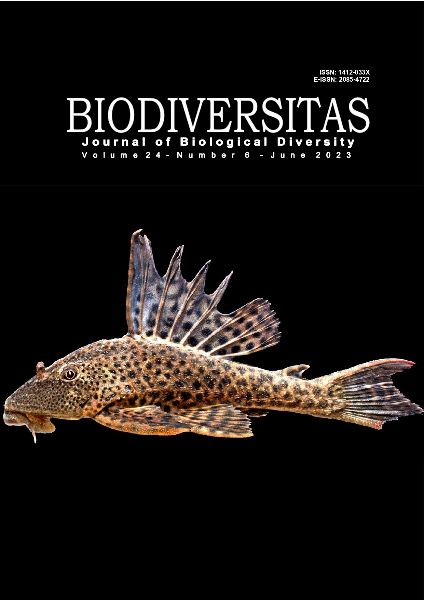Screening the anthelmintic effects of leaves and fruits extracts from various Acacia species as a potential feed for small-ruminant animals
##plugins.themes.bootstrap3.article.main##
Abstract
Abstract. Handayanta E, Hadi RF. 2023. Screening the anthelmintic effects of leaves and fruits extracts from various Acacia species as a potential feed for small-ruminant animals. Biodiversitas 24: 3140-3144. This study aimed to determine the anthelmintic properties of leaves and fruits obtained from various Acaciaspecies against Haemonchus contortus Rudolphi, 1803. Both leaf and fruit samples were allocated into five different groups: negative control (NC), 0.9% of NaCl solution; positive control (PC), albendazole solution; and solutions containing 12% concentration of each Acacia auriculiformis A.Cunn. ex Benth.(AA), Acacia mangium Willd.(AM), and Acacia crassicarpa A.Cunn. ex Benth.(AC) powder. The added concentration was set at 12%, and each treatment group was brought to incubation in 6 different time parameters (1, 2, 3, 4, 5, and 6 hours) against H. contortus. Each Acacia leaves extract did not significantly differ in eliminating H. contortus, unless for AM under 4 hours of incubation (p<0.05), wherein at the final incubation time, all Acacia-treated samples displayed complete mortality. Meanwhile, treatment with Acacia fruits during 6-hour incubations led to a removal of 76.66-83.33 % H. contortus population, in which Albendazole-treated groups showed complete mortality. Thus, this study suggested the leaves from Acacia are a potential animal feed as anthelmintic against H. contortus parasites. However, further studies investigating the potential mechanism by which various Acacia species present anthelmintic activity are necessary.
##plugins.themes.bootstrap3.article.details##
Most read articles by the same author(s)
- EKA HANDAYANTA, FAROUQ HEIDAR BARIDO, SAMANHUDI, The investigation of nitrogen, phosphorus, and potassium fertilizer on the productivity of various Sorghum bicolor varieties , Biodiversitas Journal of Biological Diversity: Vol. 25 No. 8 (2024)

